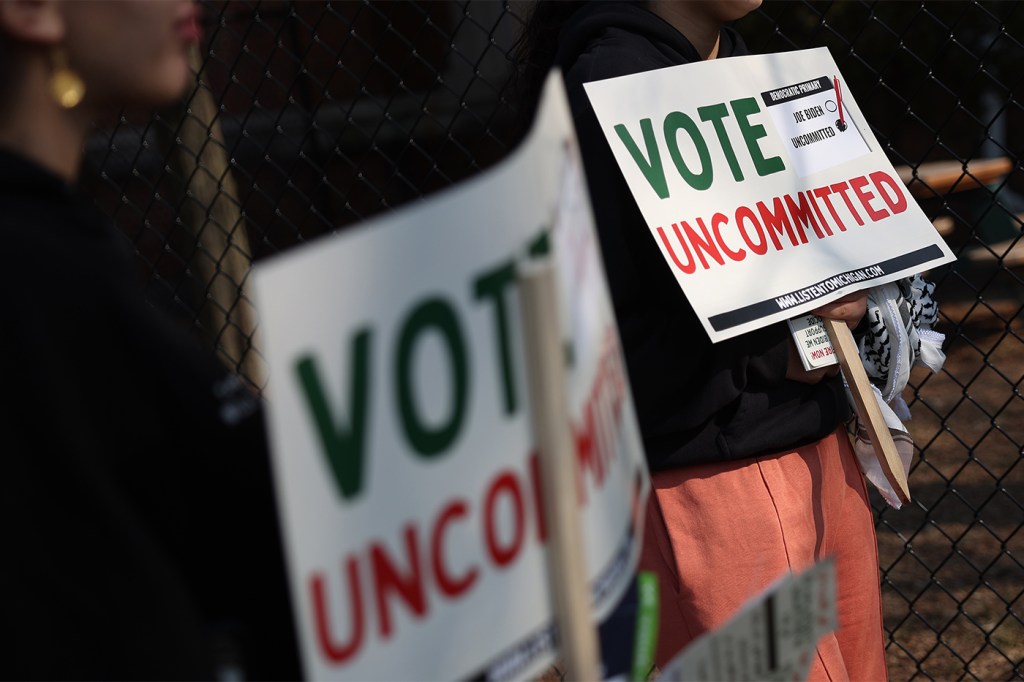Could ‘uncommitted’ or ‘no preference’ voters hand Donald Trump the 2024 presidency?
A Northeastern political scientist says that while the “uncommitted” campaign generated headlines aplenty, the votes themselves are largely symbolic.

With Nikki Haley exiting the race for president — and barring any unforeseen developments — a Biden-Trump rematch is all but locked in.
But there’s another storyline brewing. In addition to declaring Donald Trump the clear victor in the Republican primaries, Super Tuesday results showed that a large contingent of Democratic voters are declaring themselves “uncommitted” in the wake of President Joe Biden’s declining support.
What began as a local campaign in response to Biden’s handling of the Israel-Hamas war, “Listen to Michigan” has now gone national, with hundreds of thousands of registered Democrats withdrawing their support for Biden during Tuesday’s primaries.
Uncommitted, or “no preference,” votes were recorded en masse in states such as Massachusetts, North Carolina and Colorado.
Nick Beauchamp, assistant professor of political science at Northeastern, says that while the “uncommitted” campaign generated plenty of headlines, the votes themselves — given the fact that both Biden and Trump are running largely uncontested — are largely symbolic.
Northeastern Global News sat down with Beauchamp to analyze Super Tuesday’s results, and whether the uncommitted push will have any staying power come November. His comments have been edited for brevity and clarity.

Let’s start with your reaction to Super Tuesday. How do you read these results?
Mostly, it was what we expected. My take is that we’ve got an incumbent running against a semi-incumbent, and what we’ve been seeing with Biden is pretty much what one would expect with an incumbent president at this point. It’s not very different from, say, what happened with [Barack] Obama.
With Trump, he’s kind of posting a performance that’s in between what he did in 2016 and what he did in 2020, when he was a true incumbent. So the percentages are somewhere in between what you would expect for an incumbent, and what you would expect for somebody who’s not an incumbent. [Trump’s] cleared the field, and Biden had the field clear from the get-go.
The interesting question now is what happens even in the next few primaries in terms of what percentage of the voters remain undecided, and what percentage are going to “come home,” so to speak. What percentage of these Haley voters — many of them formerly supporters of [Ron] DeSantis — are going to back Trump, and how quickly is that going to happen in light of these results?
What do you make of the “uncommitted voters,” and do you see them as a response to Biden’s missteps in the Middle East? Similarly, do you think of Haley’s base in the same vein — as a cohort that may not fall back in line under Trump so easily?
Haley’s message seemed clear enough: persuade us, she says. Of course, Trump’s message is something like, “I am what I am, come back into the fold.” Consider, also, that many of the people voting for Haley were true independents; Democratic-leaning independents; and a whole host of other factions that may not vote for Trump in the general election.
Featured Posts
But some of these percentages are just artifacts of the primaries in general. Haley appeals to higher-turnout voters. Trump appeals to lower-education whites, and Haley appeals to higher-education whites — and the latter tend to turn out a lot more. In some ways, the fact that the primaries are inherently a low-turnout election sort of boosts Haley’s numbers above what we might have seen in the general election.
On the Democratic side, clearly you can trace some of the uncommitted voters in Michigan and Minnesota — and even here in Massachusetts — directly to these coordinated campaigns, which are clearly in reaction, in large part, to the war in Gaza.
When push comes to shove, do you think these no-preference voters will take their campaign all the way to the general election, or do the primaries provide a venue for them to register what could be thought of as protest votes?
I think for most of these uncommitted voters, they know that the stakes are only symbolic at this stage. There’s no effect on actual electoral outcomes, so they’re essentially cost-less protest votes.
A certain percentage of primary voters are saying that they’re not going to vote in the general election, and there’s always a percentage of Democrats who don’t vote for the Democratic candidate and vice versa. Are we going to see a larger percentage of voters who don’t? Probably a slightly larger number.
If we trust the polling, we know there’s a good number of unhappy younger voters on the Democratic side, including a number of unhappy Black and Hispanic voters. It seems fairly clear that a certain percentage of them are either not going to vote for Biden, or are going to vote for a third party, or possibly even Trump (although, that’s probably going to a very small sliver of them).
I think in terms of the Biden campaign, they’re going to be targeting the high-propensity independent voters because that’s where that campaign really sees the marginal difference. The goal for Biden and his folks is to get these voters to grit their teeth and vote for him — and avoid the scenario where they grit their teeth and vote for Trump.











